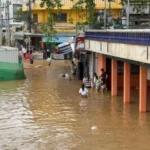Chiang Rai – As Thailand shifts from its hot season to the start of the rains, the northern provinces are getting hit with some of the highest temperatures in the country. According to the Thai Meteorological Department, all of the top ten hottest spots on April 27, 2025, were in the north, with temperatures breaking new records.
These extreme conditions highlight how the region’s climate and geography combine to push the heat even higher. Let’s look at why northern Thailand is so hot this year, which places made the list, and what it means for people living there.
Northern Thailand covers 17 provinces, including Chiang Mai, Mae Hong Son, and Lampang. The area is known for its mountains and its seasons, which differ from the rest of the country. While the south and central areas also get warm, the north faces a strong hot season from March to May.
In 2025, a low-pressure area settled over upper Thailand. Warm winds from the southeast and southwest kept the region hot, with many places reaching extreme levels. Higher elevation and the region’s location make swings in temperature more severe, especially in April, which is usually the hottest month.
The start of the rainy season is also running late this year, dragging out the heat even longer. Weather experts say the area could also see summer storms from late April to early May, adding more challenges to the mix.
This isn’t just a one-time event. On April 26, eight of the ten hottest places in Thailand were also in the north, showing how widespread the heatwave is. This year, temperatures have reached levels not seen in decades, with the heat stretching across much of South and Southeast Asia.
Top 10 Hottest Places in Northern Thailand on April 27, 2025
Here are the hottest places across northern Thailand as reported by the Thai Meteorological Department. These readings show just how strong the heatwave is:
- Muang District, Mae Hong Son – 42.3°C
Mae Hong Son’s main district hit 42.3°C, making it the hottest spot in the country. Known for its hills and diverse communities, this province often faces harsh weather. Its location by the Myanmar border and high elevation both play a role in these high temperatures. - Lampang (Site 1) – 41.8°C
Lampang, with its hot springs and old town, came in second. The low-lying areas here trap heat, making April feel even hotter. - Lampang (Site 2) – 41.6°C
A second site in Lampang made the list with 41.6°C. This shows just how widespread the heat is throughout the province. - Lampang (Site 3) – 41.4°C
A third entry from Lampang confirms the region is struggling with strong, unrelenting heat. - Chiang Rai (Muang District) – 41.2°C
Chiang Rai, known for its unique temple and peaceful feel, reached 41.2°C in its main district. Even in the far north, the heat has been intense. - Phrae (Muang District) – 41.0°C
Phrae, a smaller province known for its old houses and culture, also saw high heat at 41.0°C. - Nan (Muang District) – 40.9°C
Nan, with its striking mountains and parks, recorded 40.9°C. The heatwave has even reached these quiet corners. - Uttaradit (Muang District) – 40.8°C
Uttaradit, home to mountains like Phu Soi Dao, experienced 40.8°C. Its low plains heat up quickly in April. - Tak (Muang District) – 40.7°C
Tak, on the western edge of the north near Myanmar, hit 40.7°C. Its location makes it prone to holding on to heat. - Muang District, Chiang Mai – 40.5°C
Chiang Mai’s main area also hit 40.5°C. As a cultural hub, the city usually draws crowds, but this year’s heatwave has been hard to escape.
What These Extreme Temperatures Mean for the North
The streak of record highs in northern Thailand brings up several big worries. Health is a top concern, with the risk of heatstroke and dehydration rising—especially for older adults, children, and outdoor workers. The Meteorological Department urges everyone to drink plenty of water and avoid going out during the hottest part of the day.
Farming is also at risk. Crops in places like Nan and Lampang may struggle with the long heat. While storms expected from April 28 to May 1 might bring rain and some relief, they could also cause flash floods or hail, which add new problems for farmers.
Tourism could take a hit. Chiang Mai and Chiang Rai usually attract a lot of visitors for their temples, festivals, and natural sights. The hot season often slows down tourism, but this year’s heat could scare off even more travellers, especially with smoky air from crop fires in March and April making things worse.
With temperatures hitting all-time highs, northern Thailand is finding ways to cope. Local leaders are spreading information on how to stay cool and safe. Investments in upgrades like cooling centres and better water systems are underway to help people manage in the heat.
As these trends look set to continue, staying prepared will be key for residents, farmers, and travellers alike.
Related News:
Meteorologist Warns Over Summer Storms for Upper Thailand

Geoff Thomas is an award winning journalist known for his sharp insights and no-nonsense reporting style. Over the years he has worked for Reuters and the Canadian Press covering everything from political scandals to human interest stories. He brings a clear and direct approach to his work.














